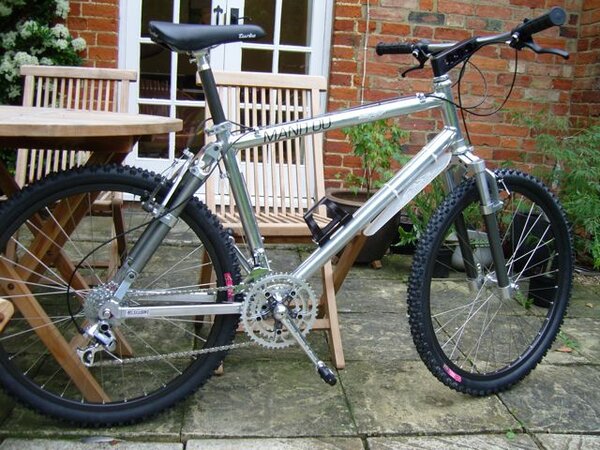Second in my little seres of development parts, the trail stem. ..
The trail stem is a rare beastie, and started the 'lightning hole' trend of early Ringlé designs. As far as production parts are concerend, the Trail stem was a pretty neat design as it covered a lot of product bases with a very few parts. The main body of the stem incorporated a hidden brake cable roller that didn't upset the aesthetic of the design. The quill was a double wedge system. Each double quill had a common (and unique to Ringlé) 'top' section, whilst the lower wedge took care of the 3 steerer sizes.

The stem bodies were then just manufactured inprogresively lower and longer reaches to cover from 100 to 160mm, ith 2 holes on the shortest, and 4 holes on the very longest

The stem was available in just blac, although as you can imagine, the early developmentjobs, weretested in the raw aluminium:

There were some other sections tried, namely just a plain I beam, shown below. This was strictly speaking lighter, but critically for the pre- v brake era, it made cable routing more of a headache, necessitating a headset hanger, and possibly alienating customers with a short steerer. Here was the first experimentation with anodizing too, but these products were stillborn, never making it to market. These are the only ones that survived


Interestingly enough, the very very first trail stem, in 1988, was what we would today call "A-head". It was a stem for geoffs 1988 Fisher Mt.Tam. This used a systemcommon to some early very high end ATBs (Ritchey and Potts spring to mind), that has an extra palin section of steerer brazed on to the fork. A normal headset was in place, but you could move the stem up and down on the plain section. Here is that stem. The first ever Ringlé bicycle product, with the steel Fisher handlebars in place:

Th trail stem was pretty cool, as it wasmachined very smoth on top, so it was pretty crash friendly, and it also took out a lot of trail buzz. Not especially light, but started a big ol' CNC thing going. . .
The trail stem is a rare beastie, and started the 'lightning hole' trend of early Ringlé designs. As far as production parts are concerend, the Trail stem was a pretty neat design as it covered a lot of product bases with a very few parts. The main body of the stem incorporated a hidden brake cable roller that didn't upset the aesthetic of the design. The quill was a double wedge system. Each double quill had a common (and unique to Ringlé) 'top' section, whilst the lower wedge took care of the 3 steerer sizes.

The stem bodies were then just manufactured inprogresively lower and longer reaches to cover from 100 to 160mm, ith 2 holes on the shortest, and 4 holes on the very longest

The stem was available in just blac, although as you can imagine, the early developmentjobs, weretested in the raw aluminium:

There were some other sections tried, namely just a plain I beam, shown below. This was strictly speaking lighter, but critically for the pre- v brake era, it made cable routing more of a headache, necessitating a headset hanger, and possibly alienating customers with a short steerer. Here was the first experimentation with anodizing too, but these products were stillborn, never making it to market. These are the only ones that survived


Interestingly enough, the very very first trail stem, in 1988, was what we would today call "A-head". It was a stem for geoffs 1988 Fisher Mt.Tam. This used a systemcommon to some early very high end ATBs (Ritchey and Potts spring to mind), that has an extra palin section of steerer brazed on to the fork. A normal headset was in place, but you could move the stem up and down on the plain section. Here is that stem. The first ever Ringlé bicycle product, with the steel Fisher handlebars in place:

Th trail stem was pretty cool, as it wasmachined very smoth on top, so it was pretty crash friendly, and it also took out a lot of trail buzz. Not especially light, but started a big ol' CNC thing going. . .
